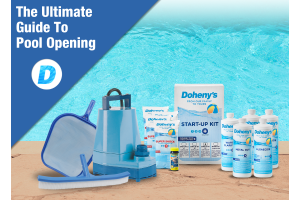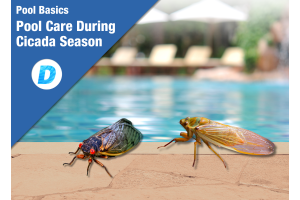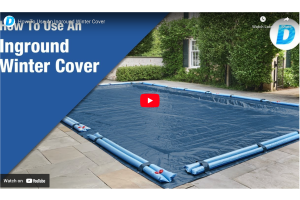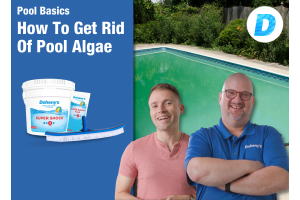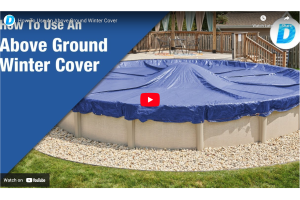How to Get Rid of Cloudy Water
Cloudy Pool Water: Get Your Water Back to Clear
It's pretty hard to keep your friends and family out of your pool on a gorgeous day, but if you notice your pool water has become cloudy, it is time to put the "No Swimming" sign up. Cloudy water is a potential hazard to your health, as it can lead to increased levels of contaminants and bacteria. In addition, poor visibility from water cloudiness is a drowning risk for swimmers.
Why is My Pool Water Cloudy?
Cloudy pool water is usually caused by one of the following common problems:
- Poor water filtration
Your pool filter may not be working properly, causing your water to become cloudy. This might be caused by a pool pump that is old or not performing well, clogs in the filter, or dirty filter media. Poor water filtration could also be caused by not running your filter for at least 8-12 hours per day during swim season. - Low levels of sanitizer
When the levels of chlorine or bromine in your water are too low, this leads to bacteria growth. Sanitizer levels may be low because of evaporation by the sun’s rays, heavy pool use, or excessive amounts of debris, such as leaves and twigs in the pool. - Unbalanced pool water
Chemical imbalances, such as high pH and alkalinity, can lead to filtration and sanitizer problems that cause cloudy water.
How to Fix Cloudy Pool Water
Planning and Preparation
You will want to set aside a couple days to ensure your swimming pool water is clear and that the chemical balance is restored. Steps include cleaning the pool, adding chemicals, and running the filtration system for at least 24 hours to ensure a clean, safe swimming environment. Plan ahead and have the following items on hand before you start:
- Pool Shock
- Water Clarifier
- Leaf skimmer
- Pool brush
- Water test kit
Inspect and Clean the Pool Filter
In order to clear the cloudy water, your filter must be functioning properly. Since a poorly functioning filter can contribute to a chemical imbalance and cloudy water, you won't be able to correct the problem without first ensuring it is not old, dirty, or damaged.
Start by cleaning the pool filter. Cartridge filters can be removed from their housing and gently cleaned with your garden hose. Sand filters and DE filters are cleaned by setting the pump to the 'backwash' setting and running the cloudy water through the sand or DE until any debris is removed. If the filter is damaged or worn, replace the filter.
Turn the filter on and confirm that the pressure is correct according to the manufacturer’s instructions. If the pressure does not return to normal after cleaning the filtration system, you may need to replace your pool pump, motor, or filter. Leaking water, losing power, or sucking in air could mean it is time to replace the pool pump. Once you confirm the filter is clean and the filtration system is functioning properly, turn it on and keep it running 24/7 until the pool water is clear.
Clean the Pool Thoroughly
Using a pool brush, give the pool a thorough scrubbing including the walls, steps, floor and ladders. Brush all surfaces of the pool to loosen any debris, then skim off any debris floating in the pool. Make sure to get behind the ladders.
Shock the Pool Water
Give your pool a supersized dose of chlorine to get rid of algae and bacteria that cause cloudiness using a powerful pool shock. Let the pool filter run overnight after adding shock.
Balance the Pool Water
Using a water test kit or test strips, check your pool’s chemical levels. Be sure that the pH is within the 7.2-7.6 range. The chlorine level should stay between 1.0 and 3.0 parts per million (ppm) to maintain a healthy pool (Chlorine levels will be higher after you shock the pool). Also ensure that alkalinity, calcium hardness, and stabilizer (cyanuric acid) levels are within the recommended ranges.
Add Water Clarifier to Your Pool
Pool clarifier helps to clear pool water more quickly. It causes the tiny particles in your water to clump together so that they are large enough to be removed by the pool filter. Pool flocculant performs similarly to a clarifier, but it causes contaminants to clump and sink to the bottom of the pool so that they can be vacuumed away. After this final step, remember to keep the pump running until the pool water is clear.
How to Prevent Cloudy Pool Water
Keep the pool water clean and clear by following a good pool maintenance routine that includes:
- Checking your water chemistry often and maintaining balanced levels all season long.
- Shocking your pool weekly or more often after heavy use or rainfall.
- Running your pool filter 8-12 hours per day during swim season.
- Promptly removing debris from the bottom of the pool and skimmers.
- Regularly brushing and vacuuming pool walls and floor.
- Cleaning your pool filter at least twice per year.
Cloudy water is a common problem for inground pool and above ground pool owners alike. The good news is that it can be fixed and prevented with a little effort and the right pool chemicals. If you need help troubleshooting your cloudy pool water, give us a call today at 800-574-7665 or visit our website at doheny.com.
To download this guide, click here.


